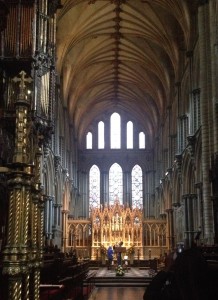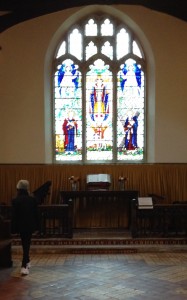Like much of Europe, England is home to many very old, very large churches and cathedrals. This just goes to show you how important Christianity was many years ago. The spread of the Christian faith was so vast, and extended to all parts of the world. This past week, we were exposed to several different ways where the influence of Christianity remains.
Earlier this week, we traveled twenty minutes by train to the town of Ely where we visited Ely cathedral. One of the most interesting things I found about this trip was not about the cathedral, but about Ely itself. It used to be called the Isle of Ely because it was, in fact, an island way back in the day. It’s a town located in the Fenlands, which is very wet and marshy, and before the marshy were drained, the town was actually an island, which I think is pretty cool.
Many parts of the Cathedral were build by the Normans and date back to the 1100s. It has a beautifully painted ceiling depicting different images of the genealogy of Christ. The painter who painted each section died halfway through, and he was replaced by someone else to finish up the mural. You can tell where one artist’s work stopped and the other’s began–the color blue used by the second artist was a little more vibrant than the first.
As for the rest of the cathedral, it was very plain and not nearly as colorful as the ceiling. This is because the walls were whitewashed during the reign of Henry VIII when he decided that he was going to be the head of the Church of England and went around plundering the wealth of the church. The walls of the cathedral were whitewashed, and the statues either had their heads removed or defaced, or they were completely destroyed. In some places, you can still see faded outlines of fleur-de-lis on the walls where decorations used to be.
On Wednesday, we walked just a few minutes down the road to the Round Church. This church is unique because of it’s shape. Just about every cathedral and church built during the first couple of centuries is in the shape of a cross. The Round church is special for just that reason: it’s round. The architecture also dates back to Norman times, and has seen the town of Cambridge grow and develop from a time when it was a trading town to its evolution into a university town.
Also on Wednesday, we shared common meal with Westfield House next door. Westfield is a seminary, and many of the students that we met were there either for their undergraduate work looking toward church work, or to become pastors. Not only is Christianity’s influence still present in the cathedrals and churches, but it was also present in this tiny group of people from the seminary.


Leave a Reply